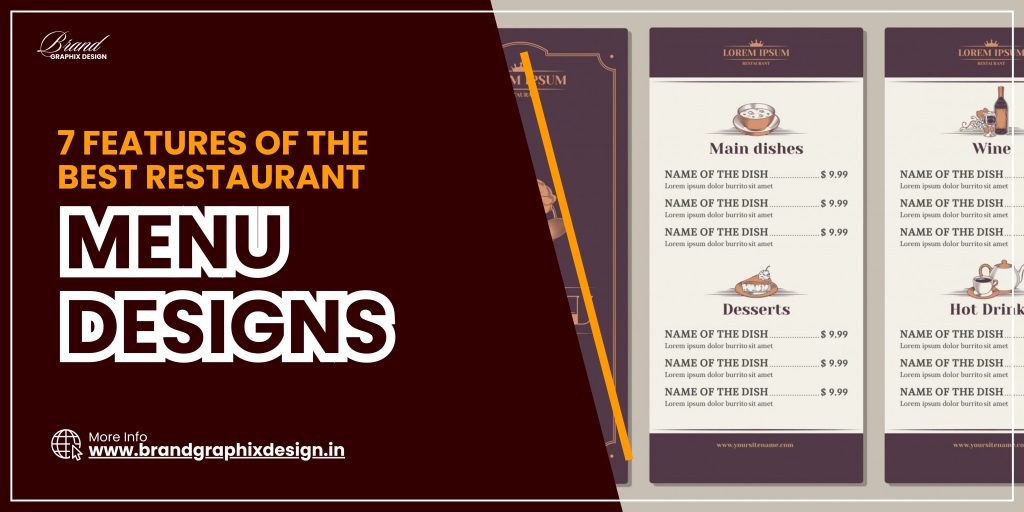A restaurant’s menu is more than just a list of dishes; it is a key part of the dining experience and an essential marketing tool. A well-designed menu can attract customers, enhance their dining experience, and even influence what they order. With so much competition in the restaurant industry, having a menu that stands out is crucial. In this blog, we will explore the 7 features of the best restaurant menu designs that can help elevate your restaurant’s appeal and boost your business.
1. Clear and Easy-to-Read Layout
The first feature of a great restaurant menu design is a clear and easy-to-read layout. Customers should be able to quickly find what they are looking for without any confusion. This means using simple fonts, organized sections, and a logical flow. A cluttered or overly complicated menu can frustrate customers and make them less likely to return. The best menus are those that are easy to navigate, with dishes categorized into sections like appetizers, mains, desserts, and beverages.
- Use simple and readable fonts.
- Organize dishes into clear sections.
- Ensure the menu has a logical flow from start to finish.
2. High-Quality Images that Entice Customers
High-quality images are a powerful tool in menu design. Pictures of food can stimulate the appetite and entice customers to order specific dishes. However, it’s important to use images selectively and ensure they are professionally shot. Poor quality or misleading images can have the opposite effect, leading to disappointment when the food arrives. The best menus use a few well-placed images that highlight signature dishes and make them look irresistible.
- Include high-quality, professional photos of signature dishes.
- Use images sparingly to avoid cluttering the menu.
- Ensure the photos accurately represent the dishes.
3. Descriptive and Tempting Dish Names
The names of the dishes on your menu can significantly impact what customers choose to order. Descriptive and tempting names can make a dish sound more appealing and encourage customers to try something new. Instead of simply listing “Grilled Chicken,” consider a more enticing name like “Succulent Grilled Chicken with Herb-Infused Butter.” A well-written dish name can create an emotional connection and make the dining experience more memorable.
- Use descriptive and tempting names for dishes.
- Highlight unique ingredients or cooking methods.
- Create a sense of anticipation and excitement with the names.
4. Balanced Use of Colors
Color plays a significant role in menu design. The right color scheme can set the tone for your restaurant and influence customer behavior. Warm colors like red and orange are known to stimulate appetite, while cooler colors like blue and green can create a calming atmosphere. The best restaurant menus use a balanced color scheme that reflects the restaurant’s theme and enhances the overall dining experience. It’s also important to ensure that the text contrasts well with the background, making it easy to read.
- Choose colors that reflect the theme and ambiance of your restaurant.
- Use warm colors to stimulate appetite and create a welcoming atmosphere.
- Ensure good contrast between text and background for readability.
5. Focus on Signature Dishes
Every restaurant has its specialties – the dishes that customers keep coming back for. Your menu should highlight these signature dishes to make sure they catch the customer’s eye. This can be done by placing them at the top of each section, using a different font, or adding a small icon next to the name. Featuring your best dishes prominently on the menu not only helps customers make a decision but also boosts the sale of your most popular items.
- Highlight signature dishes by placing them at the top of sections.
- Use different fonts or icons to draw attention to these dishes.
- Include a brief description that emphasizes why they are special.
6. Strategic Pricing that Encourages Sales
Pricing is not just about the numbers; it’s also about how those numbers are presented. Strategic pricing can influence customer choices and increase sales. For example, removing currency symbols or using whole numbers instead of decimals can make prices seem lower. Additionally, grouping similar-priced items together or offering combo deals can encourage customers to spend more. The best menus use pricing strategies that are subtle but effective in driving sales.
- Consider removing currency symbols to make prices appear lower.
- Use whole numbers instead of decimals for a cleaner look.
- Group similar-priced items together to encourage higher spending.
7. Consistent Branding Across the Menu
Your menu is an extension of your restaurant’s brand, so it’s important to maintain consistent branding throughout. This means using the same colors, fonts, and logos that are present in your restaurant’s décor, website, and marketing materials. A well-branded menu reinforces your restaurant’s identity and creates a cohesive experience for customers. Consistent branding helps customers recognize your restaurant and builds trust and loyalty over time.
- Use the same colors, fonts, and logos as your restaurant’s branding.
- Ensure the menu design aligns with the overall theme and ambiance.
- Create a cohesive and memorable brand experience for customers.
Elevate Your Restaurant with a Well-Designed Menu
A well-designed menu is a powerful tool that can enhance your restaurant’s appeal, influence customer choices, and boost sales. By focusing on these 7 key features, you can create a menu that not only looks great but also delivers results. If you need help designing a menu that reflects your brand and elevates your restaurant’s appeal, we’re here to assist. Contact us today at +91 91189 11171 to start creating a menu that stands out and drives success.


